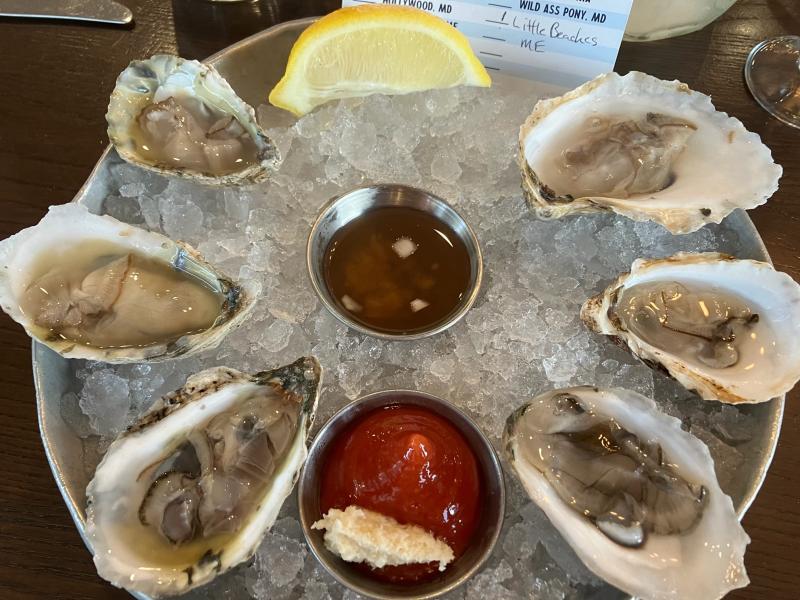Mignonette sauce brings delicate flavor to offset oysters’ salty tang
Jonathan Swift is credited with this insight from the 1700s: “It was a bold man that first ate an oyster.” Although a typical one-liner from the popular satirist, he likely heard it first in 1662 when Thomas Fuller’s Worthies of England was published with attribution of the quote to James I: “He was a very valiant man who first adventured on eating of oysters.” I can still remember my first oyster, served by my college boyfriend in his hometown of New Orleans; I’ve been a fan ever since.
But none of us was the first, since archeologists have found evidence in a South African cave that humans were eating oysters more than 164,000 years ago. They likely watched other animals eat the bivalves, and learned to roast them over a fire to pop open the shells. Oysters stay in a single location their entire lives as they grow, making them easy to harvest in the relatively shallow waters where their shells are anchored.
Since oysters were considered a delicacy by early Greeks, fishermen would scatter broken pottery pieces near places where the bivalves grew, giving them a stable place for their spat or offspring. Shells from oysters were used to cast ballots, and ancient myths assert Aphrodite, the goddess of beauty and love, was born from an oyster shell, the likely basis for the idea that oysters were an aphrodisiac.
Ancient Romans continued to value oysters as an important item for extravagant feasts. As oyster beds became depleted, the Romans designed channels and locks to control the tides so oyster beds could be formed and farmed. A variation of this approach is still in use today, along with rakes and dredges similar to those used by the Romans.
When settlers arrived in the New World, Native Americans taught them how to harvest oysters, especially in the Chesapeake Bay, home to the largest oyster population in the world. From the 18th through the 19th century, oysters were a relatively inexpensive street food and bar favorite for the masses. In New York City, the empty shells were piled high, creating what are known as middens. Lower Manhattan’s Pearl Street is named for the shells from which it was paved.
The advent of railroad transportation brought the delicious oyster from ports along the Eastern Seaboard farther into the midsection of the country. In both Europe and the United States, the abundance, low cost and availability of oysters turned them into a standard element of the daily diet, found in pies and stews at street-corner stands. By the 20th century, overharvesting depleted the oyster supply in the natural environment, and watermen turned to sustainable farming methods.
Like vineyards whose wines reflect the grape varietals and terroir of the soil where they’re grown, the specific size and flavor of oysters are determined by what type they are and where they live. Pacific Northwest oysters, such as Olympias, tend to be mild and sweet. Atlantic oysters are the most plentiful in the United States, with a crisp and salty signature. These are found in the coastal waters from Canada (Malpeques) through Massachusetts (Wellfleets), and south to Maryland and Virginia (Chesapeakes).
When eating fresh oysters on the half-shell, remember their saltiness. If you eat too many, you may end up feeling like you’ve swallowed too much seawater. To prevent that, be generous with the acidic lemon wedge and vinegary mignonette sauce, made with minced shallots, cracked pepper, and red wine vinegar. Fittingly, mignonette is derived from the French to mean “dainty, pleasing, gentle.” It’s certainly a more delicate condiment than grated horseradish in red cocktail sauce for these special treats on the half-shell.
Mignonette Sauce
Whisk together ingredients in a glass bowl. Refrigerate for at least two hours for the shallots to mellow. Serve alongside freshly shucked oysters. Sauce will last a few weeks if tightly sealed in the refrigerator.
Grilled Oysters
Preheat gas grill on high. Place shucked oysters on a perforated grill pan, shell-side down; set aside. In a small bowl, mix together the remaining ingredients. Spoon some of the sauce on each oyster. Set the grill pan on the grate and cook until the edges of the oyster begin to curl and bubble. Serve hot. Yield: 4 servings.
Baked Oysters
Preheat oven to 350 F. Coat a square baking dish or pie pan with with nonstick cooking spray; set aside. Melt butter in a small skillet over medium heat. Stir in breadcrumbs and garlic, tossing to combine. Remove from heat; mix in parsley and oregano. Spread two-thirds of breadcrumb mixture in bottom of baking dish and place oysters over crumbs in a single layer. Sprinkle with remaining crumbs and cover with cheese. Drizzle with olive oil and bake, uncovered, until crumbs are golden and juices are bubbling, about 12 to 15 minutes. Yield: 4 servings.





















































